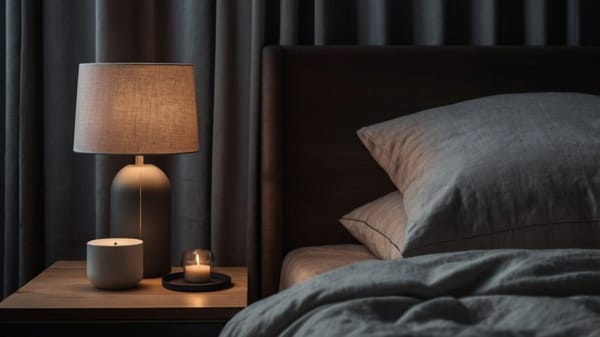How to Wake Up Refreshed Without Hitting Snooze
Wake up energized—no snooze button needed. Use a simple, science-backed morning routine to boost energy, clarity, and focus fast.

Ever wonder why you wake up groggy even after eight hours in bed? It’s not about how long you sleep—it’s about how well you sleep and how you wake.
If your morning starts with a slap to the snooze button and a fog that won’t lift, you're stuck in a cycle that’s easy to fix. Here’s how to retrain your body to wake up sharper, faster, and ready to move.
Snoozing Is a Brain Trap
It feels harmless. One more hit of the snooze button. Then another. But those extra minutes aren’t helping you feel more rested—they’re messing with your brain’s natural wake-up rhythm.
When your alarm jolts you awake, your brain is shifting out of a sleep cycle. Hit snooze, and you dip back into sleep—but not into a full cycle. Instead, you hover in light sleep, interrupted again minutes later.
This repeated disturbance prevents your brain from completing the restorative process it was built for. The result: sleep inertia, that heavy, disoriented feeling that can stick around for up to two hours.
The more you snooze, the harder it gets to feel fully alert. You're confusing your internal clock and dulling your brain’s natural cortisol response—the surge of alertness you’re supposed to get in the morning.
Here’s the truth: the snooze button is designed for comfort, not recovery. Real energy doesn’t come from stolen minutes—it comes from smarter sleep strategies.

Sync With Your Internal Clock
Your body runs on a circadian rhythm—a 24-hour cycle controlled by your brain’s master clock, the suprachiasmatic nucleus. That rhythm dictates when you feel alert, when you feel sleepy, and how well your body recovers overnight.
When you wake up at random times each day, your rhythm gets scrambled. Your energy dips, your focus suffers, and your mornings feel like a grind.
Consistency Is the Cheat Code
Wake up at the same time every day—even on weekends—and your brain begins to anticipate it. You’ll start moving into lighter sleep in the final hour of rest, making it easier to wake up naturally and feel sharper within minutes.
Anchor Your Wake-Up Time With Cues
- Light exposure within 10 minutes of waking. Natural sunlight shuts down melatonin (the sleep hormone) and spikes cortisol (the alertness hormone). Step outside, even if it’s cloudy.
- Movement. Light physical activity boosts circulation and oxygenates your brain. You don’t need a workout—just a few minutes of stretching, walking, or joint mobility.
- Hydration. Your body loses water during sleep. A full glass first thing helps jumpstart your system and clear out overnight fog.
Skip these cues, and you leave your body in sleep mode long after you’re out of bed.
Improve Sleep Quality Without Adding Hours
Let’s talk about the other side of the equation. If your sleep is low-quality, no morning routine will save you.
Sleep duration is important—but depth matters more. Deep, uninterrupted sleep is when your body repairs tissue, clears toxins, and consolidates memory. It’s also when your energy reserves are built for the day ahead.
Get Better Sleep in Less Time
You can get better quality sleep without needing more of it. Start here:
- Cool your sleep environment. 65°F (18°C) is ideal for most people. A drop in core temperature signals your brain that it’s time to sleep deeply. If your room’s too hot, you stay in lighter stages of sleep longer.
- Kill blue light at night. Phones, TVs, and computers emit blue light that delays melatonin release. Use blue light filters or glasses in the evening, or better yet—unplug 60 minutes before bed.
- Cut caffeine after midday. Caffeine has a half-life of about 5–6 hours. That late-afternoon coffee might feel harmless, but it’s still in your bloodstream when you're trying to drift off. Even if you fall asleep, your deep sleep suffers.
- Wind down with structure. Sleep is not a switch. Your brain needs cues to start shutting down. Pick one or two calming rituals—a warm shower, reading, deep breathing, low lighting—and repeat them nightly. This builds a neural link between the routine and rest.
Rewire Your Wake-Up Reflex
The snooze reflex is just that: a reflex. You’re not lazy. You’ve simply trained your brain to expect and depend on those extra minutes. Break the cycle by building a cleaner, more intentional wake-up experience.
Replace the Reflex With Ritual
Start by moving your phone or alarm clock across the room. Make yourself physically get out of bed to turn it off. This simple barrier reduces the odds of mindless snoozing.
Then, replace the snooze habit with a new cue. As soon as you’re up, flip on a light. Drink water. Open a window. Stretch.
These actions tell your nervous system, “We’re awake now.” Do this consistently for a week, and your brain will start shifting into gear faster—no mental battle required.
Train Your Body to Anticipate Wake Time
If you want to go deeper, try wake training: set your alarm for the same time daily, and don’t let yourself lie back down.
Even if you didn’t sleep well, even if you’re tired. Over time, this conditions your body to anticipate the wake time and boosts morning alertness without needing willpower.
Make Sleep a Performance Tool
Here’s what most people miss: sleep isn’t downtime. It’s active recovery. During high-quality sleep, your body releases growth hormone, repairs muscle, balances neurotransmitters, and clears metabolic waste.
Your immune system, brain function, and mood all get recharged. So if you care about energy, focus, or physical performance, you can’t afford to treat sleep like an afterthought.
Optimizing your wake-up isn’t about having a prettier morning routine. It’s about unlocking higher function in every part of your day.
More mental clarity at work. Faster reaction times in training. More stable mood and resilience when stress hits. Better recovery between workouts. It all starts with how you wake—and how you sleep the night before.
Final Thoughts: Build Your Wake-Up Blueprint
Ditch the snooze button. It’s not helping you. If you want to feel sharp in the morning, start with a consistent wake-up time, a dark and cool sleep environment, and a short, repeatable wind-down at night.
Then layer in powerful wake-up cues like light, hydration, and movement. These aren’t complicated habits. They’re low-effort changes with high-return outcomes.
You don’t need to overhaul your entire life to wake up refreshed. You just need to stop hitting pause on the one habit that shapes every other one: how you start your day.
Start tonight. Set your wake time, build a quick wind-down, and commit to no snooze. Let tomorrow morning be your first win.
Then stack another. And another. The more you repeat it, the easier—and better—it gets. Ready to make sleep your edge?




